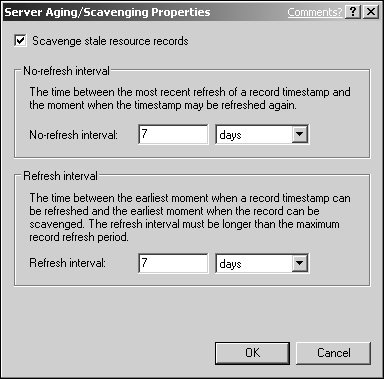Employing Windows Server 2003 Maintenance Practices
| Administrators face the often-daunting task of maintaining the Windows Server 2003 environment in the midst of daily administration and firefighting. Little time is spent identifying and then organizing maintenance processes and procedures. To decrease the number of administrative inefficiencies and the amount of firefighting an administrator must go through, it's important to identify those tasks that are important to the system's overall health and security. After they've been identified, routines should be set to ensure that the Windows Server 2003 environment is stable and reliable. Many of the maintenance processes and procedures described in the following sections are the most opportune areas to maintain. Maintaining DHCP and WINSDHCP and WINS are low-maintenance services in Windows Server 2003, but as with any other database, it's important to regularly check these databases to keep them running as efficiently as possible. WINS provides NetBIOS name resolution and uses the Extensible Storage Engine (ESE) to store system entries. The WINS database continuously updates itself by adding or deleting entries. Over time, the WINS database can contain a lot of unused space due to the changes. As a result, the database should be compacted to regain the unused space and service the environment faster and more efficiently. Windows Server 2003 dynamically compacts the database, but offline compaction is required periodically as well. Before proceeding with compaction, make sure that WINS has been successfully backed up. With the exception of the first backup, WINS backups happen automatically in Windows Server 2003. To back up the WINS database, follow these steps:
If the WINS database ever becomes corrupted, simply stop and restart the WINS service. If WINS detects corruption, it will automatically restore the most recent backup. If WINS does not detect the corruption, the administrator can force a restore by selecting Mappings, Restore Database from the WINS Manager. WINS is also designed to compact its databases automatically when they become too large. However, the administrator should compact them manually periodically. For large Windows Server 2003 environments with 1,000 systems, Microsoft recommends manually compacting the database once a month. To manually compact the WINS database, follow these steps:
DHCP maintenance is less complex than WINS maintenance. The DHCP database and related Registry entries, as listed here, are automatically backed up every 15 minutes by default. Also, the DHCP database is automatically compacted at specific intervals.
Note Specific backup and maintenance instructions are covered in detail in Chapter 10, "DHCP/WINS/Domain Controllers." Maintaining DNS Aging and ScavengingSimilar to WINS and DHCP, DNS operates efficiently on its own and requires very little intervention or maintenance. However, one way to maintain DNS is to set aging and scavenging. Depending on the number of updates and the number of records, DNS can potentially experience problems with removing stale records. Although this doesn't necessarily cause performance degradation or resolution problems in smaller networks, it may affect larger ones. As such, it's important to periodically scavenge the DNS database. Aging and scavenging are not enabled by default, so they must manually be enabled by selecting Action, Set Aging/Scavenging within the DNS snap-in. (Make sure the appropriate server is highlighted first.) Then check the box within the Server Aging/Scavenging Properties window and set the appropriate intervals, as shown in Figure 22.9. Figure 22.9. Enabling aging/scavenging for DNS. |
EAN: 2147483647
Pages: 499
